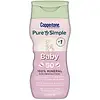What's inside
What's inside
 Key Ingredients
Key Ingredients

 Benefits
Benefits

 Concerns
Concerns

 Ingredients Side-by-side
Ingredients Side-by-side

Zinc Oxide 24.08%
Cosmetic ColorantWater
Skin ConditioningC12-15 Alkyl Benzoate
AntimicrobialIsopropyl Palmitate
EmollientButyloctyl Salicylate
Skin ConditioningEthylhexyl Isononanoate
EmollientCetyl PEG/PPG-10/1 Dimethicone
EmulsifyingPropylene Glycol
HumectantCyclopentasiloxane
EmollientBis-Octyldodecyl Dimer Dilinoleate/Propanediol Copolymer
EmollientDimethicone
EmollientEthylhexyl Methoxycrylene
Skin ConditioningPolyester-27
Camellia Sinensis Leaf Extract
AntimicrobialMacrocystis Pyrifera Extract
Skin ConditioningNelumbo Nucifera Extract
Skin ConditioningTriethoxycaprylylsilane
Beeswax
Emulsion StabilisingHydroxyacetophenone
AntioxidantPEG-12 Dimethicone Crosspolymer
EmulsifyingTocopherol
Antioxidant1,2-Hexanediol
Skin ConditioningCaprylyl Glycol
EmollientSodium Chloride
MaskingZinc Oxide 24.08%, Water, C12-15 Alkyl Benzoate, Isopropyl Palmitate, Butyloctyl Salicylate, Ethylhexyl Isononanoate, Cetyl PEG/PPG-10/1 Dimethicone, Propylene Glycol, Cyclopentasiloxane, Bis-Octyldodecyl Dimer Dilinoleate/Propanediol Copolymer, Dimethicone, Ethylhexyl Methoxycrylene, Polyester-27, Camellia Sinensis Leaf Extract, Macrocystis Pyrifera Extract, Nelumbo Nucifera Extract, Triethoxycaprylylsilane, Beeswax, Hydroxyacetophenone, PEG-12 Dimethicone Crosspolymer, Tocopherol, 1,2-Hexanediol, Caprylyl Glycol, Sodium Chloride
Homosalate 10%
Skin ConditioningEthylhexyl Salicylate 5%
UV AbsorberOctocrylene 10%
UV AbsorberZinc 7%
AntioxidantWater
Skin ConditioningC12-15 Alkyl Benzoate
AntimicrobialEthylhexyl Palmitate
EmollientEthylhexyl Stearate
EmollientCetyl PEG/PPG-10/1 Dimethicone
EmulsifyingGlycerin
HumectantHydrogenated Ethylhexyl Olivate
EmollientHydrogenated Olive Oil Unsaponifiables
EmollientIsoamyl Cocoate
Hydrogenated Castor Oil
EmollientHydrated Silica
AbrasivePolyethylene
AbrasiveTocopheryl Acetate
AntioxidantTheobroma Cacao Seed Butter
EmollientAloe Barbadensis Leaf Juice
Skin ConditioningBeeswax
Emulsion StabilisingParfum
MaskingSodium Chloride
MaskingTriethoxycaprylylsilane
Phenoxyethanol
PreservativeEthylhexylglycerin
Skin ConditioningHomosalate 10%, Ethylhexyl Salicylate 5%, Octocrylene 10%, Zinc 7%, Water, C12-15 Alkyl Benzoate, Ethylhexyl Palmitate, Ethylhexyl Stearate, Cetyl PEG/PPG-10/1 Dimethicone, Glycerin, Hydrogenated Ethylhexyl Olivate, Hydrogenated Olive Oil Unsaponifiables, Isoamyl Cocoate, Hydrogenated Castor Oil, Hydrated Silica, Polyethylene, Tocopheryl Acetate, Theobroma Cacao Seed Butter, Aloe Barbadensis Leaf Juice, Beeswax, Parfum, Sodium Chloride, Triethoxycaprylylsilane, Phenoxyethanol, Ethylhexylglycerin
Ingredients Explained
These ingredients are found in both products.
Ingredients higher up in an ingredient list are typically present in a larger amount.
Beeswax is natural wax produced by honey bees and can be synthetically created. It consists mainly of fatty acid esters and long-chain alcohols.
In cosmetics, beeswax is a emollient. Due to its waxy structure, it creates a protective barrier. This barrier prevents water from evaporating off the skin.
This may not be a good ingredient for oily skin. We recommend speaking with a professional if you have concerns.
Beeswax cannot be removed with water, but can be taken off with an oil cleanser.
Beeswax is also antiseptic and contains vitamin A.
Learn more about BeeswaxC12-15 Alkyl Benzoate is made up of Benzoic Acid and long chain alcohols. It has a low molecular weight.
C12-15 Alkyl Benzoate is an emollient and texture enhancer. Due to its solubility, it is often used in sunscreens to help evenly distribute active ingredients.
As an emollient, C12-15 Alkyl Benzoate helps soften and hydrate your skin. Emollients create a film on your skin that traps moisture within.
This ingredient has been reported to cause eye irritation.
Learn more about C12-15 Alkyl BenzoateThis ingredient is a high molecular weight silicone. It has emulsifying and skin conditioning properties.
Chances are, you eat sodium chloride every day. Sodium Chloride is also known as table salt.
This ingredient has many purposes in skincare: thickener, emulsifier, and exfoliator.
You'll most likely find this ingredient in cleansers where it is used to create a gel-like texture. As an emulsifier, it also prevents ingredients from separating.
There is much debate on whether this ingredient is comedogenic. The short answer - comedogenic ratings don't tell the whole story. Learn more about comegodenic ratings here.
The concensus about this ingredient causing acne seems to be divided. Research is needed to understand if this ingredient does cause acne.
Scrubs may use salt as the primary exfoliating ingredient.
Learn more about Sodium ChlorideTriethoxycaprylylsilane is a silicone used to bind and stabilize ingredients.
As an emulsifier, it helps prevent ingredients from separating. This can help elongate the shelf life of products.
Triethoxycaprylylsilane is often used to coat mineral sunscreens ingredients to help give a better feel. It also helps reduce oxidative stress in sunscreens.
Learn more about TriethoxycaprylylsilaneWater. It's the most common cosmetic ingredient of all. You'll usually see it at the top of ingredient lists, meaning that it makes up the largest part of the product.
So why is it so popular? Water most often acts as a solvent - this means that it helps dissolve other ingredients into the formulation.
You'll also recognize water as that liquid we all need to stay alive. If you see this, drink a glass of water. Stay hydrated!
Learn more about Water